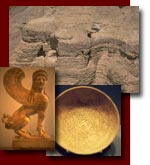| Site Map | Contacts | Links | Newsletter | |
Biblical Archaeology:
Dead Sea Scrolls
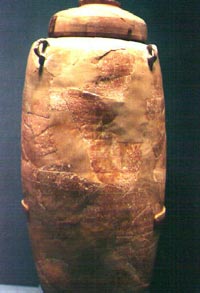 |
One of the greatest discoveries of the last century were the Dead Sea Scrolls. Large jar that the scrolls were hidden in. |
Before the Dead Sea Scrolls
Before the discovery of the Dead Sea Scrolls the Nash Papyrus was the oldest known witness to the OT which dated to the first or second century AD. It contained the Decalogue. The second oldest were the Cairo Geniza fragments (about 200,000) which date to the fifth century AD (See Princeton Geniza Project). Most of these are in the Cambridge University Library and the Bodleian Library at Oxford. Today the oldest known text of the OT was discovered in 1979 in tombs across the Hinnom valley from Jerusalem. The text is the benediction of Aaron (Numbers 6:24-26) written on a silver amulet from the 7th century BC (Hoerth 1998, 386).
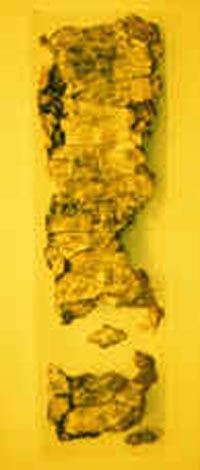 |
Oldest known text of the Old Testament from 7th century BC. discovered in 1979 in a tomb near Jerusalem. |
The oldest surviving manuscript of the complete Bible is the Codex Leningradensis which dates to 1008 AD. A Facsimile edition of this great codex is now available (Leningrad Codex 1998, Eerdmans for $225). The BHS (Biblia Hebraica Stuttgartensia) follows this codex. The most comprehensive collection of old Hebrew manuscripts is in the Russian Public Library in St. Petersburg formerly called Leningrad. Another important text is the Aleppo Codex which is now in Jerusalem. The HUB (Hebrew University Bible) follows the Aleppo Codex. The Isaiah and Jeremiah editions are now available. For a more detailed study see The Text of the Old Testament by Ernst Wurthwein and Textual Criticism: Recovering the Text of the Hebrew Bible by P. Kyle McCarter, Jr.
Discovery of the Dead Sea Scrolls
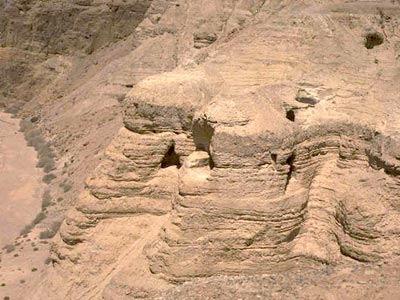
In 1947 a Bedouin shepherd boy was looking for his wandering goat when he came across a cave (see above picture). He threw a rock into the cave, and heard something break, so he went in and found large jars with scrolls in them.
Dead Sea Scrolls
The magnificent Isaiah scroll closely follows the MT, but other scrolls may follow the Septuagint (LXX), or the Samaritan Pentateuch. For example, Psalm 136 is an alphabetical psalm. Each verse begins with the next letter in the alphabet, but "N" is missing in the MT. In the DSS it is there, so somehow a scribe left this verse out. Another important difference is in I Samuel 11 where the MT is shortened. The Longer reading in the DSS explains what happens in this chapter.
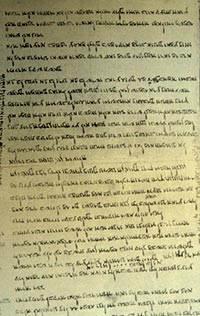 |
Page from the great Isaiah Scroll from the Dead Sea Scrolls. |
Three of the most important Biblical texts from Qumran are: (1) The Isaiah Scroll from Cave 1 which has two different text types, with about 1,375 differences from the MT. (2) The Habakkuk Commentary from Cave 1 which uses the pesher method of interpretation, and the name Yahweh is written in paleo-Hebrew. (3) The Psalm scroll from Cave 11 contains 41 canonical psalms and 7 apocryphal psalms mixed in among them. The order of the psalms differs largely from the MT (Wurthwein 1979, 32).
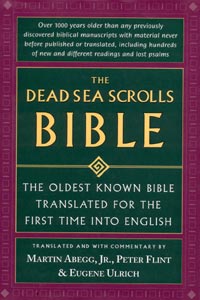 |
This is an excellent book with translations of the Bible from the Dead Sea Scrolls. Differences are italicized. The Dead Sea Scrolls Bible translated by Abegg, Flint, and Ulrich. Published by HaperSanFranciso, 1999. |
Qumran

Qumran, eight and a half miles south of Jericho, is right near the Dead Sea, and the caves where the scrolls were found. Many think the Qumran community stored their scrolls in the caves. Many identify the community at Qumran with the Essenes mentioned by Josephus and Philo. They had very strict rules. Celibacy, common property, ritual purity (see above picture of their baptismal), and separation from the world were practiced. They wrote their own Biblical commentaries, hymns, rules, and apocalyptic writings. They believed that The Teacher of Righteousness would come soon, and God would destroy the evil in the world. There is no direct evidence that John the Baptist or Jesus were dependent on the Essenes.
